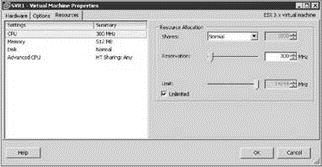Книга: Mastering VMware® Infrastructure3
CPU Reservation
CPU Reservation
As shown in Figure 9.10, the default CPU reservation for a new virtual machine starts at 0MHz. Therefore, by default a virtual machine is not guaranteed any CPU activity by the VMkernel. This means that when the virtual machine has work to be done, it places its CPU request into the CPU queue so that the VMkernel can handle the request in sequence along with all of the other virtual machines' requests. On a lightly loaded ESX host, it's unlikely the virtual machine will wait long for CPU time; however, on a heavily loaded host, the time this virtual machine may have to wait could be significant.
If we were to set a 300MHz reservation, as shown in Figure 9.11, this would effectively make that amount of CPU available instantly to this virtual machine if there is a need for CPU cycles.

Figure 9.11 A virtual machine configured with a 300 MHz reservation for CPU activity
This option also has another effect similar to that of setting a memory reservation. If each virtual machine you create has a 300 MHz reservation and your host has 6000 MHz of CPU capabilities, you can deploy no more than 20 virtual machines even if all of them are idle. The host system must be able to satisfy all of the reservation values concurrently. Now, does that mean each virtual machine is limited to its 300 MHz? Absolutely not — that's the good news. If VM1 is idle and VM2 needs more than its CPU reservation, the ESX host will schedule more clock cycles to VM2. If VM1 suddenly needs cycles, VM2 doesn't get them any more and they are assigned to VM1.
- Default CPU Allocation
- Managing the address pool, leases, and reservations
- Modifying reservation properties
- Deleting leases and reservations
- Reconciling leases and reservations
- Новый интерфейс percpu
- Inside of the central processing unit (CPU)
- Memory Reservation
- Листинг 8.4. (limit-cpu.c) Задание ограничения на использование нейтрального процессора
- Листинг 8.5. (prinf-cpu-times.c) Определение пользовательского и системного времени, затраченного на выполнение текущего...
- Allocating Virtual Machine CPU
- CPU Limit




